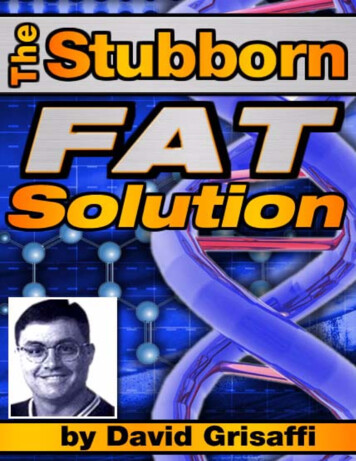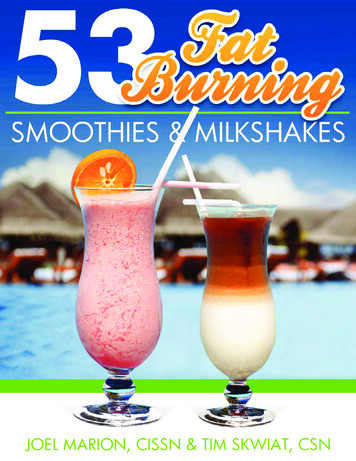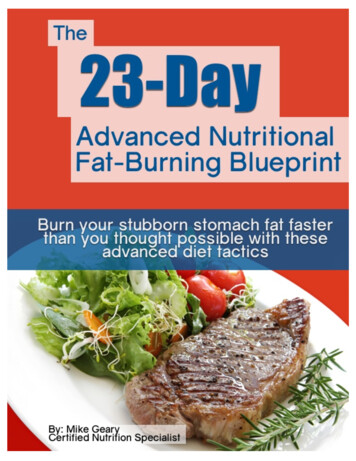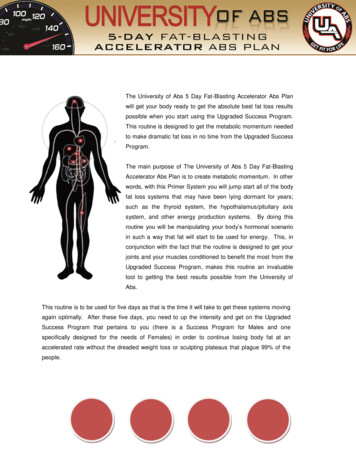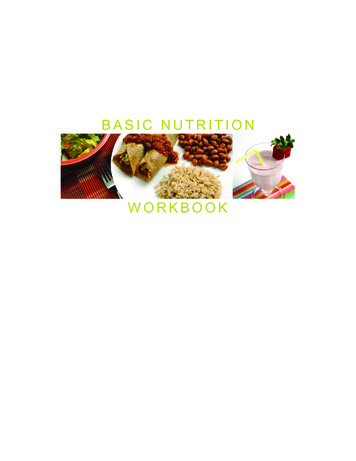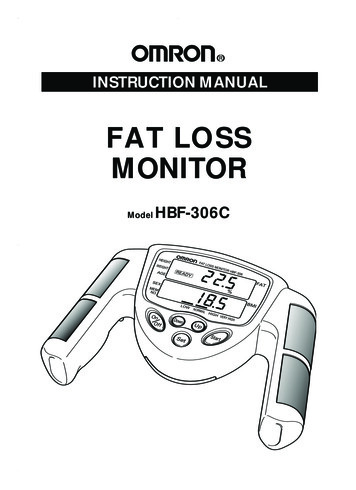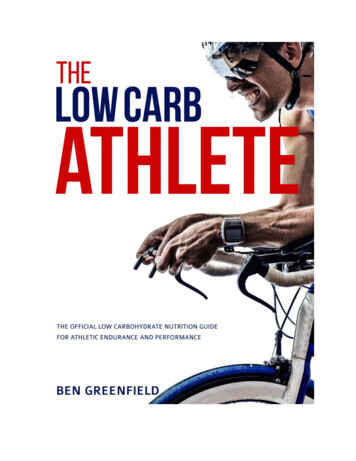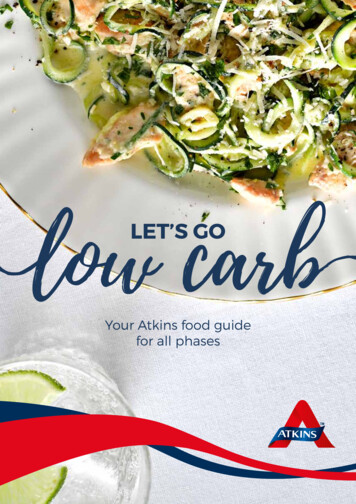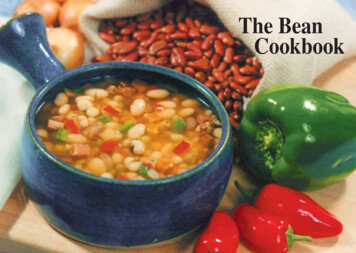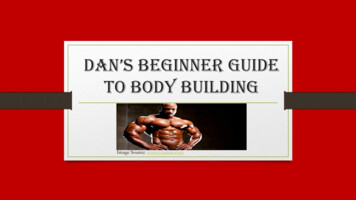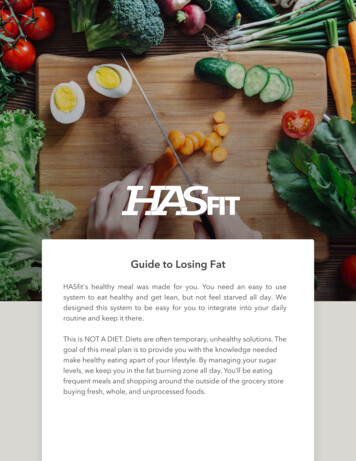
Transcription
Guide to Losing FatHASfit's healthy meal was made for you. You need an easy to usesystem to eat healthy and get lean, but not feel starved all day. Wedesigned this system to be easy for you to integrate into your dailyroutine and keep it there.This is NOT A DIET. Diets are often temporary, unhealthy solutions. Thegoal of this meal plan is to provide you with the knowledge neededmake healthy eating apart of your lifestyle. By managing your sugarlevels, we keep you in the fat burning zone all day. You’ll be eatingfrequent meals and shopping around the outside of the grocery storebuying fresh, whole, and unprocessed foods.
Believe it or notYou have to eat to lose fat!You may be asking yourself, how can I lose weight if I’m eating5 times per day? Losing weight is all about managing yoursugar levels and keeping your metabolism in a fat burningstate. If your sugar (or insulin) levels are too high, then yourbody is storing the extra sugar as fat.If you haven’t eaten in hours, then your sugar levels are low andyour body is in starvation or famine mode. A famine is a widespread scarcity of food and your body has learned to conserveenergy in times of famine. In this mode, your body isn’t burningfat because it doesn’t know when your next meal is coming.Losing weight is all about managing your sugar levels andkeeping your metabolism in a fat burning state.Our goal is to keep your sugar levels constant throughout theday. By eating every 2-4 hours and eating foods with lowglycemic levels (foods that don’t spike your sugar levels), weare able to keep your metabolism in a fat burning state. If youare used to eating only 1 or 2 meals per day, then this is goingto be a major adjustment for your body. It may be difficult toeat frequently over the first week as your body adjusts.After the first week you will notice your body will feel moreenergized, your mind will feel sharper, and you will be losingfat. Check out the graph on the following page thatdemonstrates how eating frequently will result in consistentsugar levels and more time spent in the fat burning zone.
Sumo Wrestler DietSumo wrestlers only eat once per day! They starve themselves all day, stayingin famine mode, and then they eat one huge meal to spike their sugar levels.They spend 0 time in the fat burning zone.SUGAR LEVELSFat StoringFat BurningStarvationTIME (24 hrs)Average Overweight PersonOnly eating two or three times per day means only spending half of your timein the fat burning zone, at best. If you want to lose weight, you will need tospend much more time in the fat burning zone.SUGAR LEVELSFat StoringFat BurningStarvationTIME (24 hrs)Burn Fat ALL Day!Frequent eating of smaller meals keeps your insulin levels more constant throughoutthe day. Consuming protein and low glycemic carbs also helps keep your sugarlevels under control. This combines to keep you in the fat burning zone all day long!SUGAR LEVELSFat StoringFat BurningStarvationTIME (24 hrs)
Meal Plan DirectionsThere are six meals outlined per day. You are required to eat all 3 main meals (breakfast, lunch,and dinner) and any 2 of the 3 snacks. Each meal outlines several example food choices, butyou can eat outside of the choices as long as you eat the correct amount of protein and carbs.It does not require calorie or fat counting, but does require you monitor your protein andcarbs. Total grams of protein and carbs are counted for each meal. Choose as many foodoptions as necessary to equal the allotted grams. Green vegetables count as 0 carbs. Yourproteins and carbs choices all count towards the total number.Meal Example: 6 oz turkey (30g protein / 0 carbs) 1 slice wheat bread (5g protein / 20g carbs) 1 apple (0g protein / 17g carbs) 37g carbs / 35g proteinMEAL 1: BreakfastProtein 15-25 grams - Example: Eggs, lean meats, protein powder or bar, milk,cheese, or soy)Carbohydrates 40-50 grams - Example: Oats, wheat bread, or fruitMEAL 2: SnackProtein 15-30 grams - Example: Protein powder or bar, tuna, chicken, yogurt,nuts, cheese, cottage cheese, pork, turkey, deli meats, beans, or legumes.Carbohydrates 10 grams - Only the carbs that come with your protein choice,no additional carb choice. Try to keep them under 10 g.MEAL 3: LunchProtein 30-40 grams - Example:Tuna, chicken, cottage cheese, pork, turkey,fish, deli meats, lean red meats, beans, legumes, or cheeseCarbohydrates 30-40 grams - Example: Fibrous/green vegetables, wheatbread, brown rice, mixed vegetablesMEAL 4: SnackProtein 15-30 grams - Example: Protein powder or bar, tuna, chicken, yogurt,nuts, cheese, cottage cheese, pork, turkey, deli meats, beans, or legumesCarbohydrates 10 grams - Only the carbs that come with your protein choice,no additional carb choice. Try to keep them under 10 g.MEAL 5: DinnerProtein 30-50 grams - Example: Tuna, chicken, cottage cheese, pork, turkey,deli meats, fish, lean red meats, soy, veggie burgers, beans, legumes, or cheeseCarbohydrates 20 grams on non-workout days, 40-50 on workout days Example: Fibrous/green vegetables, sweet potatoes, squash, mixed veggiesMEAL 6: SnackProtein 15-30 grams - Example: Protein powder or bar, tuna, chicken, yogurt,nuts, cheese, cottage cheese, pork, turkey, beans, or legumesCarbohydrates 10 grams - Only the carbs that come with your protein choice,no additional carb choice. Try to keep them under 10 g.
Keys to success1.2.3.4.Print the Meal Plan page and put it on your refrigerator.Read the entire plan and refer back to it often.Plan your meals ahead of time.Protein at every meal!If you are on-the-go, make your meals ahead of timeand bring them with you. Buy easy snacks like nutsand protein bars that you can take with you whereveryou go. Not having time cannot be an excuse if youare to be successful. How dedicated are you?
Avoid the following:White starches: white bread, white rice, white pasta, white potatoes, corn, and sugarStarches act just like pure sugar when entering the blood stream. You might aswell have a 2 liter of soda. Starches spike insulin levels causing the productionof fat gain. After the spike, insulin levels plummet, lowering one’s metabolicrate as the body is put into a state of starvation.More than one serving of fruit per dayFruit is to be consumed at breakfast or lunch only. The best fruit choicesinclude apples, honeydew, and berries. The worst fruit choices includebananas, oranges, and tropical fruitBeverages with caloriesNo soda. No juices. Only unsweetened tea.Carb Fat MealsMeals should be based around Protein Carbs, or Protein Fat. The worstmeals combine Carbs Fat, e.g. ice cream, pizza, alfredo pasta. Protein mustbe present in each meal.Sugary snacks or chocolate
This is You vs. You!As with all things in life, your level of success depends solely onyour level of commitment.If you only give 10% percent commitment, then you will onlyget 10% results. If you are disciplined, then you willundoubtedly be extremely successful.You now have the tools and the knowledge, but do you havethe willpower and mental strength to achieve your goals?Consider this a test, a personal challenge. You vs. You. There isno such thing as an overnight transformation, but consider howlong it took you to get to where you’re at now. The gratificationyou will feel after accomplishing this goal will far surpass anypleasure received from a late night ice cream binge. When youreach the end of this journey, you’ll be a stronger person for it.
Carb & Protein GuideNutrition Facts labels on packaged foods tell you how many carbs are in a particular food. Butmany healthy, fresh foods don’t come with labels, such as fresh vegetables or fruits. Or youmay be eating out and not able to look at the package. Use this reference guide to learn theserving sizes of carbohydrate-containing foods that you eat often.CarbsRemember: 1 serving of these foods about 15 grams of carbohydrateGrains (starches)BagelBread (white, whole-wheat, pumpernickel, rye)Crackers (white flour)Graham Crackers (2.5 inch sq)Muffin (small)Oats (cooked)Wheat PastaPita Bread (6 inch)Popcorn (low-fat)PretzelsRice (white or brown)Tortilla (6 inch, corn or flour)Tortilla Chips1/4 (1 oz)1 slice (1 oz)6 crackers3 crackers1/5 muffin (1 oz)1/2 cup1/3 cup1/2 pita3 cups3/4 oz1/3 cup1 tortilla9–13 chips (3/4 oz)Starchy Vegetables & BeansBeans (garbanzo, pinto, kidney, white) and peasBaked BeansCornLentilsPeas (green)Potato (baked, boiled, or mashed)Winter Squash1/2 cup1/3 cup1/2 cup1/2 cup1/2 cup1/2 cup or 1 medium (3oz)1 cup
Carbs (continued)FruitsApple (small, unpeeled)Applesauce (unsweetened)Apple JuiceBanana (small)Blueberries or BlackberriesCantaloupe (small)Fruit CocktailGrapes (small)Orange (small)Orange JuicePeachPeaches (canned in syrup or juice)Pear (large)Pineapple (canned)RaisinsRaspberriesStrawberries1 apple (4oz)1/2 cup1/2 cup1 banana (4oz)3/4 cup1/3 melon (11oz)1/2 cup17 (3oz)1 orange (6 1/2 oz)1/2 cup1 medium (6oz)1/2 cup1/2 (4oz)1/2 cup2 tbsp1 cup1 1/4 cup whole berriesDairy ProductsIce CreamMilk (skim, 1%, 2%, whole)Pudding (fat-free or whole)Soy Milk (fat-free or whole)Yogurt (fat-free, plain, or fruit-flavored)Yogurt (frozen, fat-free)1/2 cup1 cup1/2 cup1 cup6 oz1/3 cup
ProteinMeatsLean Red Meats (6oz)Turkey (6oz)Chicken (6oz)Fish (6oz)Deli Meat (4 slices)Tuna (1 serving)Egg (1 egg)40g8g30g22g10g15g6gDairy ProductsMilk (1 glass)Yogurt (1 serving)Cheese (1 slice)8g6g6gNutsMixed Nuts (4 handfuls or 1/2 cup)Roasted Peanuts (1/2 cup)Peanut Butter (2tbsp)Cashews (1oz)Walnuts (2oz)Pistachios (2oz)Almonds (1oz)15g17g6g5g5g6g6g
Protein (continued)SeedsSunflower Seeds (1/4 cup)Pumpkin Seeds (1/4 cup)Flax Seeds (1/4 cup)Quinoa (1/2 cup)Sesame Seeds (1oz)Hemp Seeds (1/4 cup)6g3g1g7g6.5g12gBeans & LegumesLentils (1/2 cup)Chickpeas, Garbanzo Beans (1/2 cup)Pinta, Kidney, Lima, Navy Beans (1/2 cup)Soy (1/2 cup)Split Pea (1/2 cup)Hummus (1/2 cup)10g8g8g15g8g10g
deli meats, fish, lean red meats, soy, veggie burgers, beans, legumes, or cheese Carbohydrates 20 grams on non-workout days, 40-50 on workout days - Example: Fibrous/green vegetables, sweet potatoes, squash, mixed veggies MEAL 6: Snack Protein 15-30 grams
